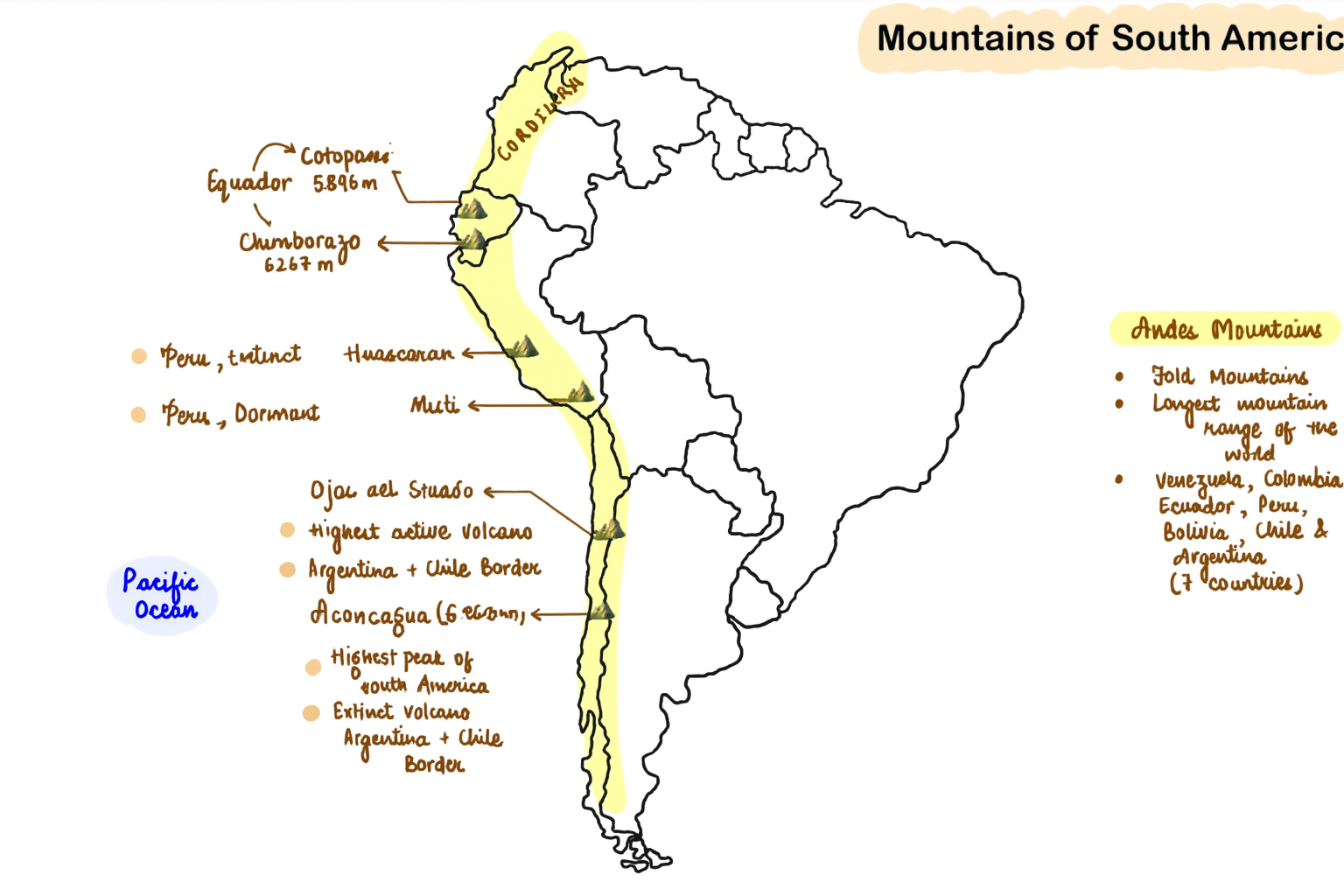🏔️ Chapter 3: Mountains & Plateaus of South America
South America’s physical structure is dominated by three major regions:
- The Andes Mountains (west).
- The Central Highlands – Guiana Highlands (north), Brazilian Highlands (east), Patagonian Plateau (south).
- The Plains & River Basins (Amazon, Orinoco, La Plata).
This chapter focuses on the mountains & plateaus.

🌎 3.1 Andes Mountains – The Backbone of South America
- Length: ~7,200 km (world’s longest continental mountain chain).
- Width: ~200–700 km.
- Countries Covered: Venezuela, Colombia, Ecuador, Peru, Bolivia, Chile, Argentina.
- Formation: Result of the Nazca Plate subducting under the South American Plate (convergent boundary).
- Importance:
- Influences climate (rain shadow → Atacama Desert).
- Source of major rivers (Amazon, Orinoco tributaries).
- Rich in minerals (copper, silver, tin, lithium).
- Habitat of ancient civilizations (Incas).
- Active part of the Pacific Ring of Fire → volcanoes & earthquakes.
🔹 Divisions of Andes
- Northern Andes (Venezuela, Colombia, Ecuador):
- Narrow, volcanic mountains.
- Peaks: Cotopaxi, Chimborazo.
- Features: Coffee-growing highlands, Quito (capital of Ecuador).
- Central Andes (Peru, Bolivia):
- Altiplano Plateau (Bolivia–Peru).
- Lake Titicaca → world’s highest navigable lake (3,812 m).
- Rich in silver (Potosí mines, Bolivia).
- Southern Andes (Chile, Argentina):
- Tallest peak: Aconcagua (6,961 m, Argentina) → highest outside Asia.
- Features: Glaciers, fjords, Patagonia region.
🔹 Important Peaks of the Andes
| Peak | Country | Height (m) | Significance |
|---|---|---|---|
| Aconcagua | Argentina | 6,961 | Highest in South America |
| Huascarán | Peru | 6,768 | Highest peak in Peru |
| Ojos del Salado | Chile/Argentina | 6,893 | World’s highest active volcano |
| Chimborazo | Ecuador | 6,263 | Farthest point from Earth’s center |
| Cotopaxi | Ecuador | 5,897 | One of the highest active volcanoes |
| Illimani | Bolivia | 6,438 | Symbolic mountain of La Paz |
🌎 3.2 Guiana Highlands
- Location: Northern South America (Venezuela, Guyana, Suriname, French Guiana, north Brazil).
- Famous Peak: Mount Roraima (~2,810 m).
- Importance:
- Source of rivers → Orinoco, Amazon tributaries.
- Angel Falls (Venezuela): Tallest waterfall in the world (979 m).
- Rich in bauxite, gold, and iron ore.
🌎 3.3 Brazilian Highlands
- Location: Eastern & southern Brazil.
- Elevation: 300–900 m.
- Importance:
- Divides Amazon Basin (north) from coastal plains (east).
- Minerals: Iron ore, manganese (Minas Gerais).
- Agriculture: Coffee, sugarcane (São Paulo region).
- Source of São Francisco & Paraná Rivers.
🌎 3.4 Patagonian Plateau
- Location: Southern Argentina, bounded by Andes (west) & Atlantic Ocean (east).
- Climate: Cold desert/steppe.
- Importance:
- Sheep grazing → wool production.
- Oil & natural gas.
- Southern glaciers and fjords in Chile.
🌎 3.5 Altiplano Plateau
- Location: Between two ranges of the Andes (Peru & Bolivia).
- Height: ~3,600–4,000 m.
- Famous For:
- Lake Titicaca (shared by Bolivia & Peru).
- Rich in lithium & salt (Salar de Uyuni → largest salt flat on Earth).
- Ancient Inca & Aymara civilizations.
📌 UPSC Key Pointers
- Andes → world’s longest mountain chain; Aconcagua → highest peak outside Asia.
- Chimborazo (Ecuador) → farthest point from Earth’s center due to equatorial bulge.
- Altiplano Plateau → Lake Titicaca & Salar de Uyuni (lithium).
- Guiana Highlands → Angel Falls (world’s tallest waterfall).
- Brazilian Highlands → Iron ore & coffee.
- Patagonian Plateau → Cold desert, sheep grazing.
- Andes = “Backbone of South America” → climate, rivers, biodiversity, resources.
